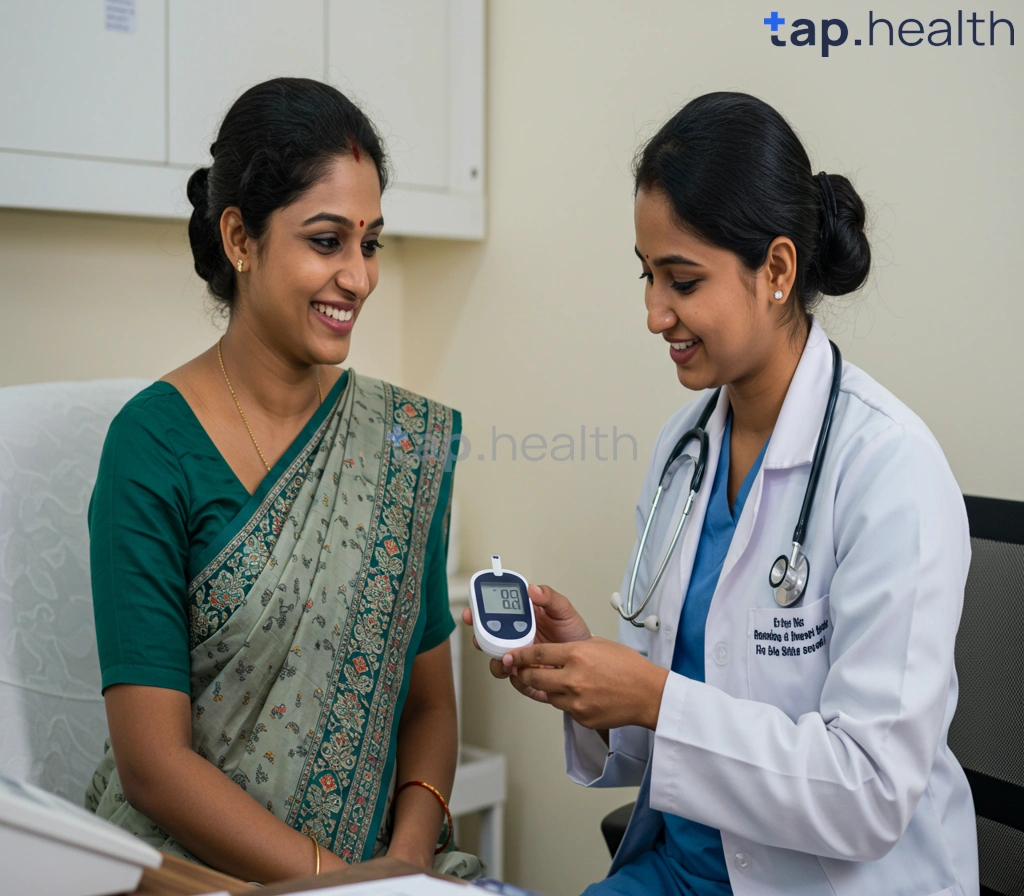Table of Contents
- Understanding Postpartum Metabolic Changes After Gestational Diabetes
- Gestational Diabetes and Long-Term Metabolic Health: A Guide for Women
- Postpartum Weight Management: Overcoming Gestational Diabetes Challenges
- Metabolic Syndrome Risk After Gestational Diabetes: Prevention Strategies
- Is Gestational Diabetes a Predictor of Future Metabolic Issues?
- Frequently Asked Questions
- References
Navigating the postpartum period is a rollercoaster of emotions and physical changes, and for women with a history of gestational diabetes (GDM), the journey can present unique challenges. This often overlooked aspect of maternal health deserves more attention, which is why we’re diving into Postpartum Metabolic Differences: Gestational Diabetes’ Long-Term Impact on Women. Understanding the potential metabolic shifts after delivery is crucial for proactive health management and preventing future health complications. We’ll explore the increased risks associated with GDM and provide actionable insights to help you prioritize your well-being during this important time. Let’s uncover the truth about how GDM can affect your long-term health.
Understanding Postpartum Metabolic Changes After Gestational Diabetes
Gestational diabetes (GDM) affects millions of women worldwide, significantly impacting their metabolism after childbirth. In India alone, an estimated 2.5 million women experience GDM annually, making understanding the postpartum consequences crucial for their long-term health. These changes are especially concerning in tropical regions where existing lifestyle factors can compound the risks.
Increased Risk of Type 2 Diabetes
After delivery, women with GDM face a substantially higher risk of developing type 2 diabetes. This increased susceptibility stems from often-persistent insulin resistance. Imagine your body’s ability to use insulin—the key that unlocks your cells to receive sugar—becoming less effective. This, combined with rapid weight gain during pregnancy and limited access to postnatal care (a common challenge in many areas), significantly increases the odds. Many women are unaware of these long-term implications, highlighting the urgent need for better support and education. This is why understanding the connection – Can You Develop Diabetes After Pregnancy? – is so vital. Can You Develop Diabetes After Pregnancy?
Metabolic Syndrome and Cardiovascular Risk
The risks extend beyond diabetes. GDM elevates the chances of developing metabolic syndrome—a cluster of conditions like high blood pressure, excess belly fat, and unhealthy cholesterol levels. This, in turn, increases the risk of cardiovascular disease, a leading cause of death globally. The high prevalence of GDM in India serves as a stark reminder of the need for preventative measures and careful monitoring after childbirth. While genetics play a role, it’s important to dispel the myth that Does Gestational Diabetes Come From the Father?.
Practical Steps for Postpartum Health
Prioritizing a healthy lifestyle post-pregnancy is paramount. This means focusing on a balanced diet brimming with fruits, vegetables, and whole grains. Regular exercise, tailored to your individual abilities, and maintaining a healthy weight are also key. Regular check-ups with your doctor, including blood glucose monitoring, are absolutely essential. In countries like India, improved access to healthcare and educational resources focused on these preventative strategies could significantly improve the long-term health outcomes for women with a history of GDM.
Gestational Diabetes and Long-Term Metabolic Health: A Guide for Women
Developing gestational diabetes (GDM) during pregnancy can significantly impact your long-term health, especially in regions like India where access to consistent healthcare might be challenging. It’s a wake-up call, not a life sentence. Think of it this way: GDM is a temporary condition, but it can signal a higher risk for developing type 2 diabetes and heart disease later on. Studies show women with diabetes face a 40% higher risk of heart disease than men with diabetes – a stark reminder of the importance of proactive management after delivery.
Understanding the Increased Risks
GDM often leads to insulin resistance, making it more likely you’ll develop type 2 diabetes later in life. This risk is amplified by factors common in many tropical regions, including lifestyle and genetics. Imagine this: Weight gain after pregnancy, coupled with less physical activity and potentially limited access to nutritious food, can create a perfect storm for insulin resistance and metabolic syndrome. Metabolic syndrome is like a cluster of bad guys – high blood sugar, high blood pressure, excess belly fat, and unhealthy cholesterol levels – all teaming up to increase your risk of heart disease, stroke, and type 2 diabetes. Knowing how to navigate this is crucial, which is why you should check out this resource on managing diabetes as you age.
Taking Control of Your Metabolic Health
Postpartum care is key. Regular check-ups with your doctor or a certified diabetes educator are essential for monitoring your blood sugar and overall metabolic health. Think of it as preventative maintenance for your body. A healthy lifestyle – regular exercise, a balanced diet packed with fruits and vegetables, and stress management – is crucial. In India, consider incorporating traditional, whole foods into your diet and seeking advice from healthcare professionals familiar with local dietary needs. And remember, knowing what to eat before your gestational diabetes test (find out here) is vital for accurate results.
Seeking Support and Resources
Don’t go it alone! Reach out to healthcare professionals, support groups, or community resources. Early intervention and consistent management dramatically reduce long-term risks. Taking proactive steps today protects your future well-being. You’ve got this!
Postpartum Weight Management: Overcoming Gestational Diabetes Challenges
Understanding the Postpartum Metabolic Shift
The postpartum period is a rollercoaster, and for women who had gestational diabetes (GDM), it presents unique metabolic hurdles. GDM significantly increases your risk of developing type 2 diabetes later in life – impacting both your health and your child’s. It’s a sobering statistic: children born to mothers with GDM are seven times more likely to develop type 2 diabetes themselves. This makes smart postpartum weight management crucial, especially in regions like India and other tropical countries where lifestyle and dietary factors can heighten these risks. Think of it like this: you’re not just looking after yourself; you’re also laying the foundation for your child’s future health.
Tailored Strategies for Postpartum Weight Management
Smart weight management after GDM needs a holistic approach—one that works with your life, not against it. In Indian and tropical climates, that means embracing readily available, culturally relevant foods. Think hearty brown rice, nutritious millets, and protein-packed legumes alongside vibrant, fiber-rich fruits and vegetables. Add in regular, moderate exercise – yoga, gentle walks – anything that fits your postpartum recovery. Crucially, personalize your plan. A doctor or registered dietitian can tailor a strategy that considers your unique needs and cultural background. Don’t just follow a generic diet; find a plan that truly works for you.
Seeking Support and Building Long-Term Habits
Juggling postpartum life with the added worry of type 2 diabetes can feel overwhelming. That’s where support shines. Online communities and local support groups are invaluable for emotional and practical support. Remember, it’s about sustainable lifestyle changes—not quick fixes. Mindful eating, consistent exercise, and regular check-ups are key to significantly reducing your risk. Managing stress is also vital. Learning effective stress management techniques (check out these resources: Stress Management Tips and Weight Gain with Type 2 Diabetes—the latter relevant if weight gain is a concern, although postpartum often focuses on weight loss). Seeking advice from healthcare professionals familiar with the unique challenges faced by women in Indian and tropical regions is also essential. You’ve got this!
Metabolic Syndrome Risk After Gestational Diabetes: Prevention Strategies
Understanding the Link Between Gestational Diabetes and Metabolic Syndrome
Having gestational diabetes (GDM) during pregnancy, especially in countries like India with unique dietary patterns, significantly increases your risk of developing metabolic syndrome later in life. This isn’t just one thing—it’s a cluster of conditions including high blood sugar, excess belly fat, high blood pressure, and unhealthy cholesterol levels. Think of it as a perfect storm brewing for heart disease, stroke, and type 2 diabetes.
The good news? Studies show that up to 80% of type 2 diabetes cases are preventable through lifestyle changes! (See this research from the PIB: Research). That’s why knowing what to avoid before your GDM test is crucial for accurate diagnosis. Check out our helpful guide: What Not to Eat Before a Gestational Diabetes Test.
Lifestyle Interventions for Prevention
The key to preventing long-term problems after GDM is a healthy lifestyle after pregnancy. This means focusing on a balanced diet packed with fruits, vegetables, and whole grains—think vibrant colors on your plate! Cut back on processed foods, sugary drinks, and unhealthy fats. Regular exercise is also vital; even short bursts of activity throughout the day can make a difference. For women in India, incorporating traditional practices like yoga or brisk walks can be incredibly beneficial and enjoyable. Don’t underestimate the power of stress management too – techniques like meditation or pranayama can help balance your system.
Making smart food choices can be tricky—we get it! Wondering about pizza? We’ve got you covered: Can I Have Pizza with Gestational Diabetes?
Seeking Support and Guidance
Postpartum care shouldn’t end with delivery. Regular check-ups with your doctor are crucial for monitoring your metabolic health. Early detection is key! Access to affordable healthcare and nutrition guidance is particularly important in India and other tropical regions. Joining a support group or working with a dietitian specializing in GDM management can provide invaluable support and personalized advice. Remember, taking proactive steps today can significantly reduce your risk of long-term complications and pave the way for a healthier future.
Is Gestational Diabetes a Predictor of Future Metabolic Issues?
Gestational diabetes (GDM)—high blood sugar during pregnancy—is becoming increasingly common, especially in tropical countries like India. While it usually disappears after childbirth, it’s a significant red flag, potentially foreshadowing future metabolic problems. The International Diabetes Federation’s Diabetes Atlas (https://diabetesatlas.org/data/en/world/) shows a staggering 61% of those with diabetes are between 20 and 64 years old – a stark reminder of the urgency to understand GDM’s long-term impact.
Increased Risk Factors in Tropical Climates
Why the higher rates in tropical regions? It’s a complex mix of factors. Think genetics, lifestyle, and access to healthcare. Obesity, insulin resistance, and a family history of diabetes significantly increase the risk. Women with GDM face a heightened chance of developing type 2 diabetes later in life, along with cardiovascular disease and other metabolic issues. It’s also important to understand how diabetes impacts fertility, as discussed in our article: How Does Diabetes Affect Fertility? Insights and Tips.
Long-Term Health Management
The good news? Proactive management can make a huge difference. After delivery, prioritizing a healthy lifestyle is key. This means a balanced diet rich in whole grains, fruits, and vegetables, combined with regular exercise. Regular checkups, including blood glucose monitoring and metabolic assessments, are crucial for early intervention. Dietary choices are paramount—check out How Many Carbs for a Bedtime Snack with Gestational Diabetes? for some helpful guidance.
Seeking Support in India and Tropical Regions
Access to quality postpartum care can be a hurdle in India and other tropical areas. Don’t hesitate to seek expert help from endocrinologists and diabetes specialists. Early intervention and consistent monitoring are your best weapons against the long-term risks of gestational diabetes. It’s about empowering women to take control of their future health.
Frequently Asked Questions on Postpartum Metabolic Differences
Q1. What is the long-term health risk associated with gestational diabetes (GDM)?
Women with GDM face a significantly higher risk of developing type 2 diabetes, metabolic syndrome (high blood pressure, excess belly fat, unhealthy cholesterol), and cardiovascular disease after childbirth. These risks are amplified by factors such as insulin resistance and limited access to postnatal care.
Q2. How can I manage my risk of developing these long-term health problems after having GDM?
Prioritize a healthy lifestyle after pregnancy. This includes a balanced diet rich in fruits, vegetables, and whole grains; regular exercise; maintaining a healthy weight; and regular check-ups with your doctor, including blood glucose monitoring. Seek support from healthcare professionals and community resources.
Q3. What are the specific challenges for postpartum health management in tropical regions like India?
In regions like India, existing lifestyle factors, limited access to healthcare and nutritious food, and potential cultural barriers can compound the risks associated with GDM. It’s important to find a healthy lifestyle plan that works within the cultural context and available resources.
Q4. What kind of support is available to help manage my health after GDM?
Support comes in various forms: regular checkups with your doctor or a certified diabetes educator, joining support groups or online communities, working with a dietitian or other healthcare professional specializing in GDM management, and utilizing culturally relevant resources.
Q5. Is it possible to prevent or significantly reduce the long-term health risks associated with GDM?
Yes, proactive management after delivery can significantly reduce long-term risks. Early detection through regular check-ups, combined with a healthy lifestyle and consistent monitoring, is crucial. Up to 80% of type 2 diabetes cases are preventable through lifestyle changes.
References
- A Practical Guide to Integrated Type 2 Diabetes Care: https://www.hse.ie/eng/services/list/2/primarycare/east-coast-diabetes-service/management-of-type-2-diabetes/diabetes-and-pregnancy/icgp-guide-to-integrated-type-2.pdf
- Disparate Model Performance and Stability in Machine Learning Clinical Support for Diabetes and Heart Diseases: https://arxiv.org/pdf/2412.19495





